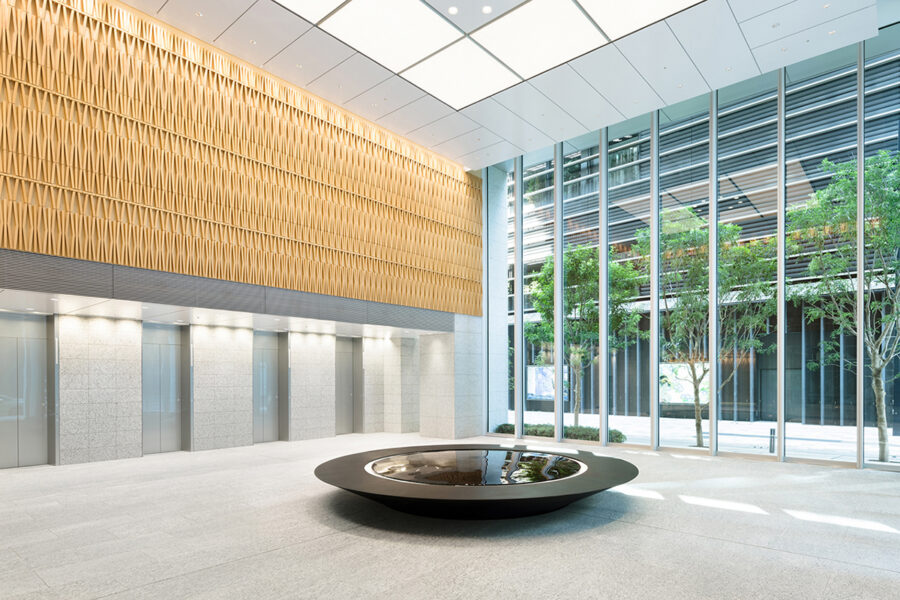〈Echo House〉は、中国北京市郊外、60年代北京の紡績時代を支えたレンガ造倉庫を改修したヴィーガンレストランの計画である。
施主は自然との調和を求めるというコンセプトで活動しており、設計においても積極的に外在要素を意識することを求めた。
我々は「並存(Coexist)」という概念のもと、8つの具体的な設計ルールを設け、施主の要望を受け止めることにした。
それらのルールはすべて両様的な意味をはらむ設えとし、立ち現れる空間や物の細部にわずかな違和感を付与させ、概念的な「ゆがみ」や「不旋律」が生み出す冗長的空間体験を模索した。
・外部から動線を視覚的に認知でき、その様は立体的とすること。
・内部から外部を視認でき、その視点は変化すること。
・低密度で延伸的な動線とし、それらは空間化されていること。
・間仕切りや扉を設けない、ひと続きの立体空間とし、各場所の用途は外部との関係において決定すること。
・環境計画はまず、自然の斉一性にもとづいたデザインとし、機械設備は補助的な役割とすること。
・構造は力の流れを認識できる単純な形式とするが、装飾性をあわせ力学的緊張感だけを強調しないこと。
・素材は現地における施工技術に対して現実的で、過去の時間を未来に繋ぐことができる選択とする。
・什器は建築的に創作され、プロダクトと建築の間をまたぐものとする。
設計、現場監理打ち合わせはすべてオンラインで行った。普段であれば日本から現場へ数回行くが、新型コロナ蔓延による渡航制限もあり、結局竣工まで一度も現場へ行くことはかなわなかった。
さまざまな要因で工事が遅延したが、施主や施工会社の粘り強い努力、またいくつかのデジタルコミュニケーションツールを活かし常に状況を確認することで無事工事を終えオープンを迎えることができた。(神山 義浩)
A vegan restaurant renovated from a brick warehouse with the theme of coexistence
The Echo House is a Vegan Cooking Research lab + Gallery, workshop space, from which a red brick warehouse has been renovated in the Beijing spinning area in the 1960s.
Since the clients have a strong intention of connecting the space with ecological environment, the design specially emphasized the relationship between the space indoor and outdoor.
To pursue the concept of “Coexist”, the geometry, design detail and materials chosen are mainly designed under 8 design principles to fulfill the client’s requirements. All of these principles have multiple perspectives, and the completed space and details encourage visitors to interact with them in various ways.
• Approach from outside can be visually recognized and should be three dimensional.
• Visitors can see the outside environment from the inside
• Turning a low-density and elongated circulation to a space.
• Designing a continuous three-dimensional space without partitions or doors, and deciding the purpose of each place in relation to the outside.
• Passive Design comes first in the building environment consideration, mechanical add-up becomes optional.
• A Hybrid Structure system is not only to emphasize the mechanical tension ,but also to express the flow of force.
• The building material shall be convenient to get for the local construction technology and should
be able to connect the past time to the future.
• Artefact shall be created across a meaning of both the product’s and architectural design.
The design and construction supervision is accomplished fully online. As a result of the corona pandemic, the regular site visits from Tokyo are all cancelled. No site confirmation can be made before and after the completion of the building.
Even though there are multiple elements that postpone the construction, thanks to the clients’ efforts and all digital communication technology, the construction ends up smoothly and now is already open for business. (Yoshihiro Kamiyama)
【Echo House】
所在地:北京市朝陽区半載塔路53 郎園StationA1-8C
用途:カフェ、ギャラリー
クライアント:北京自由回声餐飲有限公司
竣工:2020年
設計:KLC
担当:神山 義浩、Colin.L、Lauren.L
構造設計:A+A workshop
施工:A+A workshop
撮影:Yuming Song (Beijing Ruijing Photography)
工事種別:コンバージョン
構造:混構造
規模:地上2階
敷地面積:146.60m²
建築面積:133.20m²
延床面積:257.10m²
設計期間:2019.07-2019.12
施工期間:2019.10-2020.10
【EchoHouse】
Location: A1-8C, Lang Yuan Station, No. 53, Ban Jie Ta Lu, Chaoyang District, Beijing
Principal use: Cafe, Gallery
Client: Free echo (Beijing) Culture Communication
Completion: 2020
Architects: KLC
Design team: Yoshihiro Kamiyama, Colin.L, Lauren.L
Structure engineer: A+A workshop
Contractor: A+A workshop
Photographs: Yuming Song (Beijing Ruijing Photography)
Construction type: Conversion
Main structure: Wood, Mixed structure
Building scale: 2 Stories
Site area: 146.60m²
Building area: 133.20m²
Total floor area: 257.10m²
Design term: 2019.07-2019.12
Construction term: 2019.10-2020.10








